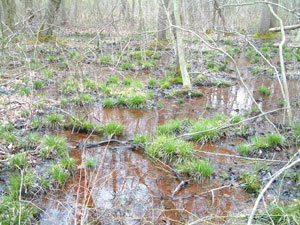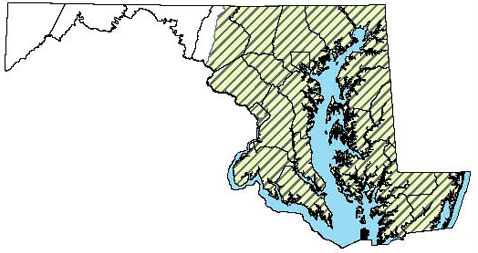Field Guide to Maryland's Frogs and Toads (Order Anura)
Main_Content
Eastern Spadefoot (Scaphiopus holbrookii) | Photo by: John White
| | Former Name: Eastern Spadefoot Toad |
Size:
- 1¾ - 2¼ inches
- Record - 2⅞ inches.
|
Appearance:- A relatively smooth-skinned toad without parotoid glands
- Has grayish brown back with two yellowish lines running from behind eyes down the back in a “lyre-shaped” pattern.
- Small reddish orange spots may also be present.
- Key diagnostic feature is the dark brown, elongated, sickle-shaped spade on the bottom of each hindfoot.
- It also has vertically elliptical pupils.
|
Habitats:- Areas of sandy, loose soil in or adjacent to forests.
- Typically observed during breeding, in shallow depressions or vernal wetlands in open areas (pastures, fields) adjacent to woods.
- Primarily found on Coastal Plain.

Photo of Habitat for Eastern Spadefoot
courtesy of Rebecca Chalmers
|
How to Find:- Listen for their distinctive explosive grunt call “geeoo”, likened to the sound of young crows, on nights during or following torrential rains, with air temperatures 50o F.
- They are explosive breeders, calling only 2-5 nights per year at any one site.
- Breeding can occur from March-September, but usually from late March to mid-May.
- May also be found crossing roads on warm rainy nights.
|
Distribution in Maryland:Eastern spadefoots can be found throughout the piedmont and coastal plain sections of Maryland.  | | For More Information: |
|
